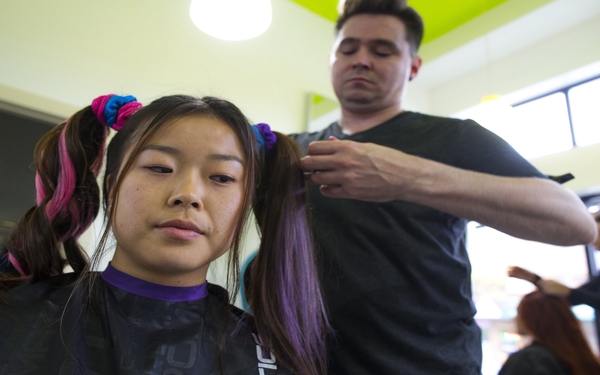One little stitch up the side of a pocket can make a world of difference.
A few inches trimmed from the shoulders of a shirt can transform a shape — and, more importantly, make the wearer feel like their true self.
Their true gender.
Leo Roux designed his new eponymous line of clothing for transgender people out of necessity.
Roux, 31, transitioned from female to male in 2012 and struggled to find clothes that didn’t hug his curves or highlight his narrow shoulders.
It was a daily frustration, because clothes are such a huge part of the transgender story.
“One of the ways you first start experimenting with gender are different pronouns, maybe a different name,” Roux said the other day, sitting in a coffee shop near his West Seattle home. “Clothing is right up there with that.
“It’s how we show up in the world,” he said. “How we present ourselves is through clothing.”
But finding the right fit presents a huge challenge.
Trans men — those born female but identifying as male — tend to be smaller than cisgender males (those who identify with the gender they were at birth). They also have wider hips and more narrow shoulders.
Trans women — those born male who identify as female — tend to be taller than cisgender women. They also have narrower hips and are more muscular and angular.
“We tend to make do with clothing,” Roux said. “We hunt for it and make do with what we find.”
For him and most transgender males, that means rolling up jeans. Shopping in the boys department. (“They’re adolescent styles, but at least they fit.”)
A trans woman will wear a cardigan to camouflage broader shoulders; or a dress with an empire waistline that, as Roux put it, “Takes the hips out of the equation.”
“People never find their personal style because of all this,” Roux said. “And you think, ‘If a clothing company could just incorporate things from the ground up, that would go a long way to finding a solution to all these problems.’ ”
He couldn’t find one. So he started his own.
Roux is a massage therapist who never designed clothing before.
“That’s unless you count the chain mail shirt I made during high school,” he cracked.
So he started with the basics: Jeans and shirts, and one dress design. Nothing flashy or fancy — which is all he sees when he looks at online clothing sites for transgender people.
“There’s a lack of casual clothing that fits us well and flatters us the way we want to be flattered,” he said. “Clothing that gets our gender.”
Clothing that also makes you feel confident — and safe.
“To be able to pick up a pair of jeans as opposed to agonizing, and wondering ‘What are people thinking of me when they look at me from behind?’” he said. “People can look at your hips and you feel unsafe. There’s a lot of angst.”
Roux’s pattern maker has worked for Levi’s, Betsey Johnson and Cirque du Soleil; and he got feedback from therapists who work with transgender people before cutting any fabric.
Roux put his clothes online on Oct. 26, and will fill orders once he has enough to make it worthwhile. He needs enough preorders to be able to purchase wholesale fabric and meet the factory minimums for each garment. (The clothes will be made in the U.S., he added.)
The price point ranges from $34 for a T-shirt to $61 for a dress, $78 for jeans and $80 for a button-down shirt.
No one will be charged unless they have met their minimum order by Nov. 23.
“I hope everyone likes it as much as we do,” Roux said. “I want to offer people clothing that makes you feel like you can be a part of society.”
The transfeminine line includes a dress with a cowl neck that draws the eye to the neck and away from the shoulders. The jeans are tailored at the knee and flare out to accentuate the curvature of the thighs and hips.
The transmasculine line includes a crew-cut, color-blocked shirt with the lighter color on top to emphasize the width of the shoulders, and a wide cut at the hips.
The jeans in both lines are made of stretchy material.
“I figured I would just roll up my sleeves, learn what I needed to make things happen, and take it one step at a time,” Roux said.
He was born Louise in South Africa and moved to the United States with his family in 1996. He double-majored in English and German at the University of Texas, then worked for the Texas German Dialect Project. He trained to become an auto mechanic, then worked as a produce manager.
It was then — while dating a woman — that Roux became aware of the desire to transition.
“I didn’t want to be called anyone’s girlfriend, and I didn’t know what I wanted to be called,” Roux said. After speaking with transgender people and a therapist, “The light bulb went off in my head.”
“That was the answer,” Roux said of his decision to transition. “I realized what was bothering me and took measures to deal with it.
“It was like night and day, my happiness with myself and my body.”
He hopes that his clothes bring that same feeling to those who have struggled to dress the way they feel inside.
“It makes a real psychological difference to have clothes that help you present who you want to,” he said. “I want people to be happy they found us.”
———
©2016 The Seattle Times
Visit The Seattle Times at www.seattletimes.com
Distributed by Tribune Content Agency, LLC.












